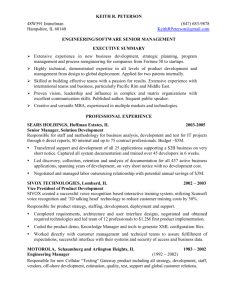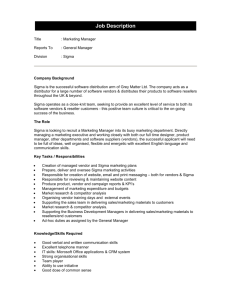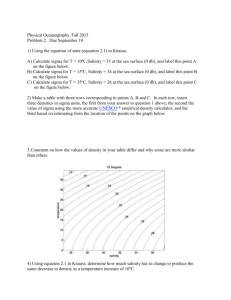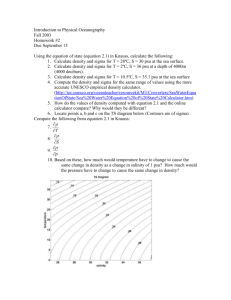Six Sigma and CMM : Showdown in Software Process Engineering
advertisement
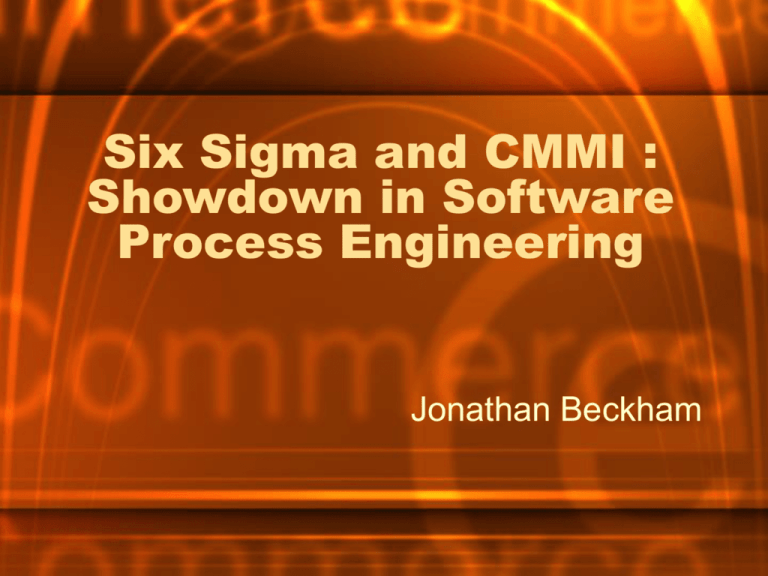
Six Sigma and CMMI : Showdown in Software Process Engineering Jonathan Beckham Process Improvement Goals • Process Goals – Improve schedule and budget predictability – Improve cycle time / time to market – Increase productivity – Improve quality (as measured by defects) – Increase customer satisfaction – Improve employee morale – Decrease cost of quality Process Improvement Goals • Companies want to increase Return On Investment What affects software? People Process Technology Six Sigma: What is it? • According to David Card, (IEEE Software 2000), Six sigma is “A generic quantitative approach to improvement that applies to any process.” • “Six Sigma is a disciplined, data-driven approach and methodology for eliminating defects (driving towards six standard deviations between the mean and the nearest specification limit) in any process -- from manufacturing to transactional and from product to service.” –isixsigma.com What’s the missing piece? • In essence, six sigma is an approach to finding the cause of business problems and solving them making an impact on the bottom line of a corporation and decreasing variation for products. • Six Sigma is more of a methodology or a philosophy. Six Sigma Levels • Six Sigma can be identified at three levels: – Metric – Methodology – Philosophy Metric • 3.4 Defects Per Million Opportunities (DPMO) • DPMO allows you take complexity of product/process into account • Refers to statistics. The +-6 standard deviations (sigmas) away from the standard mean • Most companies are within 3 standard deviations of the mean Metric • The higher the sigma value, the better the process is capable of producing defect free results. • To be in this six sigma range you must have a quality product 99.9999998% of the time. Philosophy • Reduce variation in your business and make customer-focused, data driven decisions • Translate customer needs into operational measurements Methodology • Structured problem solving techniques and roadmap • Two primary sub-methodologies in Six Sigma – DMAIC – DMADV DMAIC • Define-Measure-Analyze-Improve-Control • Tool for incremental process improvement of existing processes within an organization that fall below required specification DMAIC cont. • Define – Define the problem or process to improve upon related to the customer and goals • Measure – How can you measure this process in a systematic way? • Analyze – Analyze the process or problem and identify the way in which it can be improved. What are the root causes of problems within the process? • Improve – Once you know the causes of the problems, present solutions for them and implement them • Control – Utilize Statistical Process Control to continuously measure your results and ensure you are improving – Several Software Packages available to assist in measuring yield, defects per million opportunities, etc. DMADV • Define-Measure-Analyze-Design-Verify • Methodology for producing new processes that meet the Six Sigma Quality levels desired • Similar to DMAIC, however, we have a design stage here • DFSS – Design-For-Six-Sigma – Using models or prototypes to create designs and ensure they are effective in meeting goals DMAIC VS. DMADV Six Sigma Personnel • Champion – Manager/Director/Executive who makes sure the resources are in place for a Six Sigma project • Master Black Belts – Quality experts in an organization – Responsible for strategic implementation – Teach/Mentor other Black and Green Belts • Black Belts – Six Sigma team leaders responsible for implementing process improvement projects within the business • Green Belts – Employee of an organization that has some training in Six Sigma and may lead a Six Sigma project, but only as part of their job CMM: What is it? • “A Capability Maturity Model (CMM) is a reference model of mature practices in a specified discipline, used to improve and appraise a group’s capability to perform that discipline” -SEI • CMM contains a list of key process areas that includes software engineering, project management, and process improvement divided into different levels CMMI • CMM sunset – No more SEI CMM training since 2003 • Some vendors may still offer it – CMM Appraisals will end this year • SEI states other vendors may offer this but questions value • Version 1.1 CMMI released in December 2001 – Adds requirements development, validation – Identifies strategy for verification and validation or products (testing) – Adds relevant stakeholders and level of involvement (Identify key people) – Less focus on “documented procedures” (Only when critical to a process) CMMI Models • Capability Maturity Model Integration brings together four disciplines – Systems Engineering (SE) – Software Engineering (SW) – Integrated Product and Process Development (IPPD) (Level 3 add on) – Supplier Sourcing (SS) or Acquisition (Level 3 add on) CMMI Maturity Levels Maturity Levels of Organizations 9/28/04 SW-CMMI Strengths • Engineering focused which assists in integration and interaction among engineering departments • Recognized Internationally • DOD contracts require certain levels for bids • Utilizes best practices in the industry Six Sigma Strengths • Generic Process Improvement Strategy can be applied to any process • Trained personnel working on process improvements for organization on continuous basis SW-CMMI Weaknesses • Statistical methods often not used at levels 4 and 5 when they could ease data analysis – Six Sigma embraces statistical methods – Improvement in CMMI • CMMI goals are not always aligned with business and customer goals – Generally Software Specific, but improving with CMMI • CMMI assessors are certified, but implementers are not so they may not understand underlying concepts (statistical process control, etc) – Six Sigma has competence certifications for relevant subject matter Six Sigma Weaknesses • Derived from manufacturing which has a real tangible process that is easy to measure and apparent, as opposed to software engineering • No formal connection to ISO 9000 – ISO 9000 and CMM have milestones and certifications • Six Sigma relies on training personnel (black belts) that look for areas that need improvement which may not be the best way to go about this – Costs also involved in training for Six Sigma • Focuses on Internal process experience and doesn’t consider external technology or best practices CMMI Case Studies • Lockheed Martin M&DS – SW CMM ML 2 (1993) – SW CMM ML 3 (1996) – CMMI SW ML5 (2002) – Increased software productivity by 30% – Decreased unit software cost by 20% – Decreased defect find and fix costs by 15% CMMI Case Studies • Bosch Gasoline Systems – CMM Level 4 – Predictability – internal on-time delivery improved by 15% – Less Rework – first pass yield improved by 10% – Product Quality – reduction in error cases in company by one order of magnitude Six Sigma Case Study • >$3 billion energy company • Customer dissatisfaction with software deliverables • Customer satisfaction improved by 2 points on their “report card” • Product quality was improved by 30% • Reduction of rework by 50% was achieved • Project savings of $150 K was achieved So which one is better? • • • • “The is no silver bullet” – Fred Brooks Neither one is necessarily “better” Both have weaknesses Both have multiple case studies and large corporations that have realized real savings and process improvements utilizing their techniques • Utilizing both is possible CMM and Six Sigma Similarities • Both emphasize reducing defects as their main process improvement goal • Both focus on quantitative decision making that relies on measurement – Six Sigma and CMM level 4 and 5 • Both utilize similar basic statistical process control techniques – As mentioned, Six Sigma has a better foundation in this area Using Six Sigma and CMM • Six sigma provides a foundation to define, measure, analyze, improve, and control the process – Utilize process mapping • Can work in conjunction with CMM to map out a process and identify gaps within software processes – Failure Modes and Effects Analysis • Detects how a process can fail and assigns severity to it to prioritize actions Using Six Sigma and CMM • CMM level 4 and 5 and Six Sigma are often seen as similar: – Six Sigma training can help to deal with CMM’s Quantitative Process Management and Defect Prevention requirements – CMM can clarify how to use Six Sigma techniques for software process – Important to note that organizations can achieve level 4 and 5 without using Six Sigma techniques • Many utilize their own statistical methods and analysis • Sometimes ad-hoc, as mentioned before CMM does not tell you necessarily how to accomplish a level, just what need to be accomplished Benefits from SW CMM and Six Sigma • Study of utilizing them together: – Tata Consultancy Service development center reduced cost of process failures from 5 to 1 percent, thus reducing total quality cost – Improved cycle time and productivity – Scheduled slippage was reduced from a range of +-20 percent to +-2 percent saving the company roughly $700k over 3 years – Amazingly, at the time of the article, clients had not reported any defects in their software products! Summary • Six Sigma is a process methodology that focuses on quantitatively measuring a process in order to control and improve upon it • Six Sigma strives for 3.4 Defects Per Million Opportunities (DPMO) so that it is within six standard deviations of the mean • SW CMMI is a process improvement model for software engineering that is divided into levels and contains a list of key process areas Summary • Six Sigma and CMMI can be utilized together to improve the software engineering process • Six Sigma’s more advanced statistical methods can be applied to assist in quantitatively analyzing data within CMMI’s level 4 and 5 • Six Sigma can also complement any individual process within CMMI by utilizing techniques such as process mapping Conclusion • Lastly, the effects of implementing Six Sigma and CMMI can highly improve the quality of the product developed and individual processes which can directly impact a business's bottom line and customer satisfaction References • David N. Card, “Sorting out Six Sigma and the CMM”, IEEE Software, May June 2000, pp. 11-13 • Jack Horgan, “Six Sigma and CMM”, September 13 - 17, 2004, http://www10.edacafe.com/nbc/articles/view_weekly.php?articleid=20 9200 • M. Murugappan and G. Keeni, “Blending CMM and Six Sigma to Meet Business Goals”, IEEE Software, March/April 2003 • “IT Perspective: Balancing Six Sigma and the Capability Maturity Model (CMM ®/CMMI SM )”, http://www.gartner.com/4_decision_tools/measurement/measure_it_a rticles/2002_10/six_sig.jsp • SEI Website, http://www.sei.cmm.edu/ • Six Sigma, http://www.isixsigma.com/ • Thomas Pyzdek, "DMAIC and DMADV", Pyzdek Consulting, Inc. Six Sigma Handbook, http://www.pyzdek.com/DMAICDMADV.htm Questions Or Comments?

